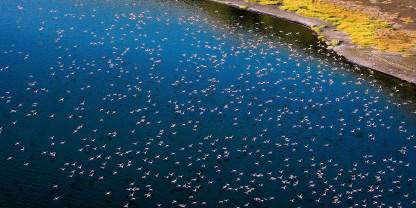Average Expert Rating
Rating Breakdown
Write a User ReviewKenya’s Ultimate Adventure
Although you can fly from Nairobi to Lake Turkana, that’s the least interesting way of
Read more
getting there. For me the way to get the most from Lake Turkana is to give yourself 10 days to 2 weeks and go overland. There are three overland routes to the lake. The easiest, but in my opinion least rewarding, is the route up the western side of the lake to the drab town of Lodwar. Far better is to loop to and from the lake travelling via the bird-filled Lake Baringo, the cool, green highland town of Maralal, the fascinating Samburu village of South Horr and on to the lakeside village of Loiyangalani. For the return journey, head over the blank sands of the Chalbi desert through little North Horr with its camel herders and nomads, to the forested mountain town of Marsabit before heading south to the rest of Kenya via the Samburu Reserve. The going on this route is very tough, roads are dreadful, distances long, accommodation and food primitive but my oh my what rewards. After years of travel across much of Africa I can safely say that there are few areas on this continent that are as exciting to travel. This is a genuine wilderness experience of ever changing landscapes and, despite me saying this wasn’t a wildlife safari as such, there are some animals (north Kenya is actually the only part of eastern Africa where I have seen elephants strolling about outside of any protected area), with the lake itself being home to a massive population of Nile crocodile, which are easily seen on Central Island where they nest.But it’s the people that are of real interest here. Numerous tribal groups, living largely traditional lifestyles live up here: the Samburu, Turkana, Rendile, Borana and more all call the north home. Over the years I have spent months exploring Lake Turkana and the far north of Kenya and every time has been a real adventure. I’ve snapped my jeep’s drive shaft twice on the terrible roads, climbed mountains with feather-bejeweled Samburu moran, seen a baby elephant no more than an hour old in a forest clearing, had men with Kalashnikovs and spears pour tea leaves and soap into my jeep radiator at three in the morning (don’t ask!), chewed miraa (a leafy stimulant commonly consumed in the north of Kenya) with Somali truck drivers, slept in Samburu and Turkana villages, followed goat herders about their day and ridden boats out to desert islands populated with zillions of giant crocodiles. A journey to Turkana won’t appeal to everyone but for those in search of a totally different kind of ‘safari’ experience and who are willing to face up to real, unpackaged, genuine adventure, a safari to Lake Turkana will leave you with unforgettable memories – it certainly has for me.
The Jade Sea: An Oasis in the Desert
Lake Turkana is the largest desert lake in the world and also the largest alkaline lake. Standing on the sandy shore and looking out across the water it’s hard to believe it’s not an ocean. The unfailingly welcoming local Turkana tribe, whose fascinating culture is similar to the iconic Maasai but less tainted by Western tourism, call the lake the Jade Sea, which
Read more
is testament to both its size and the beautiful jade colour of the water.Turkana is not for the faint of heart and certainly not on most Kenyan safari itineraries. But for those looking to see a completely different side of Kenya it’s a truly special destination.
The World’s Largest Desert Lake
Lake Turkana is not, in my view, primarily a wildlife destination, though you are likely to see the like of gerenuk, Beisa oryx and various dry-country birds including Somali ostrich on the long dusty drive there, while crocodile are plentiful in the lake itself. The main attraction is the remote windswept setting of this beautiful lake, a deep jade apparition that contrasts with the surrounding desert scenery, and the opportunity to interact with some of Africa’s most staunchly traditionalist tribes, among them the pastoralist Turkana and Samburu, and the El Molo community of fisherfolk. Exploration for oil, which resumed in 2023 after a gap of several years, threatens to bring this remote wilderness firmly into the 21st century. So best catch it soon!
Emerald Splash in an Untamed Terrain
There are three national parks at Lake Turkana: Sibiloi National Park, South Island National Park and Central Island National Park. Much of the wildlife that you find here is fitting to the harsh landscape, including Nile crocodile, plentiful venomous snakes and scorpions. Mammals include zebras, hippopotamus, gazelle, hartebeest, lion and cheetah, though this isn’t the place to come to see big cats.
Facilities here are few and you won’t meet many other travelers and that is the appeal. Traveling
Read more
in a Landcruiser across bleak desert and past dramatic volcanic backdrops, encountering traditionally dressed nomadic pastoralists herding their camels, and sleeping in absolute tranquility in rustic Turkana-style huts beside the lake are among my favorite Kenya experiences.The Jade Sea in Kenya’s Remote Northern Region
Reaching the lake involves crossing the inhospitable Chalbi Desert, a rewarding journey for adventurous travelers. During my trip north I also explored other highlights, including Samburu National Reserve and Marsabit National Park.
Wildlife is scarce, but animals you might see include gerenuk, dik-dik, reticulated giraffe and Beisa oryx. When out on the lake you’ll probably see some monster crocodiles as well. Fishing is a significant activity in Lake Turkana and an important food source for local communities. Nile perch and Turkana tilapia are the main targets for sport fishing.
For me, the most interesting aspect of this remote region is the opportunity to interact with people from ancient tribes

